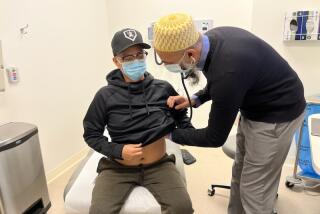About 15% of Americans with HIV donât know theyâre infected, CDC report says
Half of the Americans recently diagnosed with HIV had been living with the virus for at least three years without realizing it, missing out on opportunities for early treatment and in some cases spreading it to others, according to a new report by the Centers for Disease Control and Prevention.
Whatâs more, of the 39,720 Americans newly diagnosed with HIV in 2015, one-quarter had been infected for seven years or more without knowing they were ill.
Among all 1.2 million Americans living with HIV in 2015, the CDC estimates that about 15% were unaware of their HIV-positive status. Those people are thought to be responsible for 40% of new transmissions of HIV, according to the study published Tuesday in the CDCâs Morbidity and Mortality Weekly Report.
The human immunodeficiency virus, or HIV, is responsible for causing AIDS. Infection used to be considered a death sentence, until antiretroviral medications capable of suppressing the virus came into broad use in the late 1990s.
The new report is the latest measure of how well public health authorities are doing at boosting rates of early diagnosis and care for HIV â goals that will extend life expectancies for patients and reduce the virusâ spread.
For each of the new cases diagnosed in 2015, researchers estimated a rough time of infection on the basis of a patientâs level of disease progression. Based on patientsâ initial count of infection-fighting CD4 cells, they gleaned how long the HIV virus likely had replicated unchecked. A normal range for CD4 cells lies between 500 and 1,500; a CD4 count below 200 brings a diagnosis of AIDS.
Although the median time between infection and diagnosis for all Americans was three years, there was considerable variability among patients of different racial and ethnic groups.
For instance, half of African Americans had been infected for 3.3 years when they were diagnosed, while the median time for whites was 2.2 years. This gap was seen despite the fact that African Americans were more likely than whites to have been tested for HIV in the previous year.
For Latinos, the median time to diagnosis was also 3.3 years; for Asian Americans, it was 4.2 years.
The authors of the CDC report surmised that the longer diagnosis delay among nonwhite racial and ethnic groups might reflect an observed trend: For whites, men who have sex with men are the predominant sources of HIV spread, but for other groups, sexual contact between men and women is responsible for a higher proportion of infections.
Age, too, was a key factor, with older patients more likely than younger ones to go years without knowing they were HIV-positive. Half of newly-diagnosed patients 55 and over were HIV-positive for 4.5 years or more without knowing it. Among those 34 and younger, the median delay between infection and diagnosis was about 2.5 years.
Fully half of people with undiagnosed HIV infection in 2015 were living in the South, the CDC said. States with the highest rates of undiagnosed HIV infection â between 16% and 19% â included Nevada, Arizona, Texas, Michigan, Iowa, Indiana, North Dakota and Wisconsin. New Jersey, Pennsylvania, Vermont and South Dakota and Idaho had the lowest rates, between 5% and 10%.
Overall, the three-year gap between infection and diagnosis actually represents progress. In 2011 â the last time the CDC took such measures â half of Americans newly diagnosed with HIV had been infected for 3.6 years or more.
That suggests that public health campaigns started by the CDC, including the âTesting Makes Us Strongerâ push rolled out in 11 cities, have made inroads. Two CDC campaigns, launched in 2007 and 2011, set out to encourage testing and early HIV care on the part of African Americans and Latinos, and particularly among men who have sex with men.
Such public health efforts have increased rates of testing among many groups at high risk. Among men who have sex with men, 71% told surveyors they had been tested in the last year, as did 58% of people who inject drugs. Only 41% of heterosexual Americans at increased risk of HIV infection said they had been tested in the last 12 months.
Taking HIV medicine as prescribed allows people with the virus to live a virtually normal lifespan, generally without health complications. Managing oneâs HIV infection with medication also significantly reduces the likelihood of transmitting the virus to sexual partners.
âThe benefits are clear,â said Dr. Jonathan Mermin, director of the CDCâs National Center for HIV/AIDS, Viral Hepatitis, STD, and TB Prevention. âPrompt diagnosis is prevention. It is the first step to protecting people living with HIV and their partners.â
The CDC recommends testing all people between the age of 13 and 64 for HIV at least once in their lifetime, and people at higher risk for HIV â including IV drug users and sexual partners of infected persons â at least annually. Healthcare providers may find it beneficial to test some sexually active gay and bisexual men as frequently as every three to six months.
Dr. Brenda Fitzgerald, the CDCâs director, called the new statistics âmore encouraging signs that the tide continues to turn on our nationâs HIV epidemic.â
HIV is being diagnosed more quickly, Fitzgerald said. The number of people who have the virus under control is up, and annual infections are down, she added.
âWhile we celebrate our progress, we pledge to work together to end this epidemic forever,â she said.
More to Read
Sign up for Essential California
The most important California stories and recommendations in your inbox every morning.
You may occasionally receive promotional content from the Los Angeles Times.











